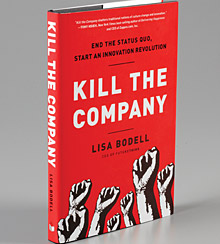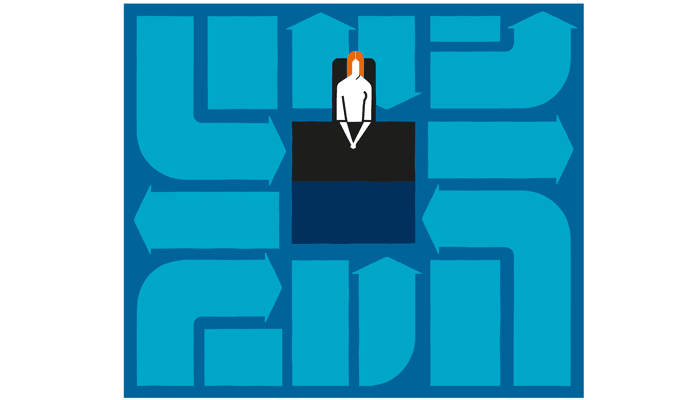Best Business Books 2012: Organizational Culture
Small Talk
(originally published by Booz & Company)
Marvin R. Weisbord
Productive Workplaces: Dignity, Meaning, and Community in the 21st Century: 25th Anniversary Edition
(Jossey-Bass, 2012)
Lisa Bodell
Kill the Company: End the Status Quo, Start an Innovation Revolution
(Bibliomotion, 2012)
Talk, Inc.: How Trusted Leaders Use Conversation to Power Their Organizations
(Harvard Business Review Press, 2012)
The intense focus on corporate change during the last decade has given us a greater appreciation of the role that culture plays in organizations. Change efforts can succeed only if the culture is engaged; getting the strategy and other formal elements right is never enough. And culture is vested in people — how they work, what they believe, how they behave and communicate, and what they ask of themselves. It’s the bedrock reality of an organization, its true ground. When culture is harnessed, extraordinary transformations can occur.
Witness the experience of Hindustan Petroleum Corporation Ltd. (HPCL), as described by Boris Groysberg and Michael Slind in Talk, Inc.: How Trusted Leaders Use Conversion to Power Their Organizations. As part of a strategic initiative aimed at making the huge, partially state-owned, heavily unionized company more innovative and productive, its leaders sent cross-functional teams drawn from the ranks of young employees into remote regions of India to conduct field research and “live where the market was, for about two or three weeks.”
The resulting exchanges yielded critical insights into how HPCL could improve its retail performance in rural areas, for example, by building small, inexpensive fueling stations along secondary roads. This innovation not only improved the company’s performance and gave it access to enormous untapped markets, but also spurred engagement among the young employees. Seeing their ideas put into action on a massive scale gave them a sense of ownership in their company. Employee buy-in, bolstered by ongoing efforts intended to create a coherent organizational vision and culture, has proved invaluable to the company. For example, when a general strike was called throughout the Indian energy sector, HPCL was the only state-owned company that continued to operate, because its managers and staff felt too responsible for its welfare to walk out.
Many of this year’s business books recognize culture’s role as the essential driver of effective change. But frequently their suggestions for engaging the levers of culture are limited to exhortation: Be more open! Behave less hierarchically! Become a change agent! By contrast, the three books reviewed here offer highly specific ways of engaging culture to build more effective, productive, and innovative organizations.
Déjà Review
Productive Workplaces: Dignity, Meaning, and Community in the 21st Century: 25th Anniversary Edition (originally published in 1987 as Productive Workplaces: Organizing and Managing for Dignity, Meaning, and Community) draws on Marvin R. Weisbord’s dual perspectives as a thoughtful and inquiring business manager and an indefatigable student of management practice. The book’s reissue, updated and expanded, offers nothing less than a history of how cultural innovations have pushed organizations to become more productive over the last century and a half.
Inheriting a position in his family’s printing business in the late 1950s, Weisbord quite naturally adopted the heroic, top-down style of leading that was then so prevalent as to be almost unquestioned. In essence, he made decisions and gave orders that he expected the frontline people in his company to carry out, while he also tried to define the processes and methods they should use. But a few sobering experiences soon convinced him that the people he was ordering around knew a lot more about their jobs than he did. What they really needed from the boss was freedom and support so they could make the best use of their skills.
This insight prompted Weisbord to undertake a personal journey to discover how to help people create the conditions under which they could be most effective rather than imposing standards or methods on them. He read widely and made a point of spending time with some of the great pioneers of participative management, collaborative learning, and systems thinking: Kurt Lewin, Douglas McGregor, Eric Trist, Fred Emery, and Warren Bennis. He turned his own company into a learning lab where he put to work the ideas he was discovering, eventually becoming a consultant and writing about what he had learned.
The result was the first edition of Productive Workplaces, a highly personal, sometimes idiosyncratic account of Weisbord’s quest to become a better leader, and a wise and timeless contribution to the literature of work that a quarter-century later is the year’s best business book on organizational culture. In the new edition, Weisbord recasts some of his stories from management history, describes his recent work with collaborative teaming, and offers both updated and new cases.
The new chapter on “Ten Management Myths” alone, in which the author summarizes five decades of experience, makes this edition worth reading. One myth is the belief that large-scale interventions and Day One transformations have the capacity to change an organization’s culture. But Weisbord’s experience has convinced him that organizations actually change only one small step at a time. “If you seek a new ‘culture,’” he advises, “make every meeting congruent with the culture you seek.” This means focusing on what is happening in the here and now. Creating real change means “giving these people, in this room, at this moment, opportunities they never had before.” Culture exists and is manifest in day-to-day business.
Several of Weisbord’s myths are based on the premise that leaders make primarily rational decisions. He’s skeptical of executives who justify every action as dictated by profit, believing that their real bottom line is more often the desire to maintain and expand their power. He similarly questions the routine use of layoffs, which he describes as “trading skills, experience, future capability, and competitive advantage for short-term cash.” It’s not that layoffs are necessarily wrong, but that they have become a habit in many organizations, a response embedded in and reinforced by the culture. Weisbord encourages cultures that take a case-by-case approach, honoring Mary Parker Follett’s “law of the situation,” which not surprisingly focuses on what’s happening here and now.
Weisbord sees an inherent tension between top-down management and participative cultures. He traces this dynamic back to Frederick Taylor, who was both an efficiency engineer and a fierce advocate of workplace democracy. Taylor’s struggle to integrate his holistic and systemic instincts with his desire to quantify and measure performance created an internal dialogue that Weisbord believes has shaped organizational cultures ever since. He discerns a similar dialogue at work in Douglas McGregor’s highly influential Theory X (top-down control) and Theory Y (people can be trusted to do their work), viewing these two organizational types not as opposing ideologies but as polarities that express the full spectrum of an organizational culture that is ultimately rooted in the complexity of human nature.
Weisbord’s narrative voice in Productive Workplaces — which is both a history of organizational management and a personal story — is direct and free from cant, skeptical of big claims and sweeping changes. The author is a passionate incrementalist whose words demonstrate the humanity at the heart of his enterprise. The reissue of his classic book is cause for celebration.
A Killer Culture
In Kill the Company: End the Status Quo, Start an Innovation Revolution, Lisa Bodell, founder of an innovation research and training firm, offers up a whole menu of tools aimed at freeing people’s capacity for innovation. Her focus is not on organizational realignment, but rather on the daily practices that can get people thinking, talking, and acting in new ways — culture change at its most granular.
Where Weisbord focuses on productivity, Bodell focuses on innovation. To create a culture that supports innovation, Bodell advocates giving people the opportunity to try new practices. She believes that if you get people doing things differently, their thinking — and culture change — will follow. Like Weisbord, Bodell disdains grandiosity and proclamations of large-scale transformation. Instead, she provides counterintuitive exercises aimed at getting people in organizations to address both short- and long-term problems in innovative ways.
The counterintuitive aspect is a key characteristic here, because a significant amount of organizational work in recent years has focused on getting people to describe a glowing future and then figure out how to attain it. In Bodell’s view, this approach can too easily lead to the kind of boilerplate and rote responses that actually stymie practical creativity. Likewise, she finds the “think outside the box” battle cry far too general to be useful. Instead, she advocates flipping the appreciative inquiry model on its head in order to foster the kind of provocative straight talk that gets people in teams thinking differently.
Exhibit A is an ingenious and well-developed exercise called “Kill the Company,” which asks participants to step into their competitors’ shoes and think up a detailed strategy aimed at driving their own company out of business. This is achieved by encouraging people to identify weaknesses in their company — or their business unit or division — and show how a savvy competitor could exploit them. According to Bodell, the most useful insights surface when participants consider specific scenarios. They should seek to answer questions such as, “What steps could a competitor take that would cut pricing by half on one of our main products?” “If we were hosting a public forum called ‘How Our Services Really Suck,’ what would be the main discussion topic?” “If someone were writing a tell-all book about our company, what painful secrets would they reveal?”
A second methodology, “Kill the Stupid Rules,” focuses attention on non-essentials that get in everybody’s way. Most stupid rules, Bodell notes, are enshrined policies that, over time, become “how we do things around here” — that is, part of the culture. Often they’re minor but familiar irritations: expense documentation requirements, IT departments’ blocking of access to useful websites, monthly operating reports that eat up significant amounts of time to prepare and review. When asked to identify stupid rules, Bodell finds that most of a company’s employees offer up the same suggestions, indicating that widespread frustration has become routine. She also observes that by agreeing to jettison rules widely perceived as idiotic, leaders can garner an almost unreasonable return in loyalty and respect.
A third method, “Provocative Inquiry,” recasts brainstorming to generate more pointed results. Bodell observes that most brainstorming fails to fulfill its promise because the questions are either too generic or framed in ways that elicit barriers to action rather than action. Ask people, “What do we want to look like in 10 years?” and you’re liable to get generalities in response: “We want to be number one in our sector.” But ask a group to name three microtrends that could transform their business and you’re likely to get a more robust and thoughtful discussion. For example: If passwords become obsolete, what will take their place, and how could our financial-services unit benefit from the shift?
Bodell urges organizations to focus on behaviors and parameters even when framing an organizational vision. Instead of urging people to take risks, for instance, define risk in concrete terms and set limits for it. Instead of offering up idealistic prose about the need for collaboration between units, create a “lazy intellectual property list” that helps people identify ideas from other units that they could help develop. Always, the emphasis is on specificity and framing provocative questions, the essential starting point for conversations that spur actionable change. And the writing in Bodell’s book models the practices she’s developed — it’s direct, clear, and refreshingly to the point.
Talk, Talk
Fans of Boris Groysberg’s brilliant and data-rich Chasing Stars: The Myth of Talent and the Portability of Performance (Princeton University Press), which I reviewed for s+b as 2010’s best business book on human capital, may be surprised by the nuts-and-bolts approach of the Harvard Business School professor’s latest effort. But what Talk, Inc.: How Trusted Leaders Use Conversation to Power Their Organizations, which is coauthored by former Fast Company editor Michael Slind, lacks in academic heft and quantitative scope, it more than makes up for in practical relevance.
Talk, Inc.’s guiding premise is that the strength and consistency of an organization’s culture can be judged by the quality of its communications. The “organizational conversation” not only manifests the culture, it also plays a key role in shaping it. Talk, therefore, is a powerful tool for creating and promulgating more powerful and more aligned cultures.
Groysberg and Slind distinguish organizational conversation from corporate communications, noting that the latter function grew out of the command-and-control model and served in part as a means of controlling talk. They note that people today require a less hierarchical approach, one that acknowledges and supports how information actually circulates through a company. Leaders can’t control this kind of talk, but they can engage in it, and in the process unleash an energy greater than any leader can command.
The authors believe that effective organizational conversation always involves a combination of four elements: intimacy, interactivity, inclusion, and intentionality. They fully describe each element, and provide case studies and actionable takeaways.
Intimacy means that talk takes place face-to-face: informally, between two people or in small groups. Leaders who communicate intimately do so by talking to people at every level of the organization in ways that are personal, authentic, and transparent with regards to intent. They address real concerns in direct language that avoids euphemism and condescension. Because it is rooted in relationships, intimate talk demands that leaders “get real,” meaning that they have to listen and to be willing to examine their own underlying motives and presumptions about the people with whom they are engaging.
Interactivity means that talk is two-way: there is a give-and-take. Profoundly social by nature, interactive talk both elicits responses and provides a means for participants to pass on information. The authors note that interactivity is well served by social media platforms, which facilitate and sometimes mandate two-way communication. But they caution that such technologies are tools that, if misused, can just as easily be counterproductive. Chat windows, for example, are highly ineffective at generating interactive communication because participants perceive one another as “people in a box” rather than partners in an authentic conversation.
Groysberg and Slind offer Cisco as a robust example of a company that successfully uses technology to keep the talk flowing and the culture coherent. Cisco’s development and use of TelePresence — which simulates in-person meetings by beaming high-definition, life-sized video feeds between locations — is especially instructive. To create it, the company’s engineers extensively studied the conditions that spur interactivity in videoconferencing sessions. They discovered that scale is critical — an on-screen person needs to appear at 80 percent or more of his or her size to spur active engagement. Exchanges at eye level and unobstructed views of body language are also essential.
Inclusion means relying chiefly on employees’ talk to generate ideas and content. “If you let them build it, they will come,” write Groysberg and Slind, who then provide dozens of examples for putting this principle to effective use, focusing in particular on the EMC Corporation. When the data storage giant’s leaders needed supporting content for their submission to an annual Best Companies to Work For survey, they didn’t ask corporate communications to prepare the materials. Instead, they community-sourced it by putting the request out on their intranet. Employees presented and documented their own experiences, posting photos and videos and speaking through blogs, and EMC used their content to support the submission.
Finally, intentionality means that talk is purposeful as well as flowing. Groysberg and Slind note that those who speak with intention do so with a sense of where they hope the conversation will lead and what they want to accomplish. In organizations, intentionality is expressed by making sure internal conversations are aligned with operational and competitive goals. In the past, such strategic formulations were designed and disseminated from the top, but Groysberg and Slind argue that to be effective today, agreement must be generated in the talk that circulates throughout the company. This can’t happen unless people in the organization are able to see their enterprise as a whole and understand what colleagues in different units and at different levels are really doing. Conversations that serve intentionality must therefore bring different segments together, giving participants a comprehensive sense of their organization and its place in the larger world.
Talk, Inc. makes a powerful case that effective talk is the primary means of motivating and inspiring loyalty among today’s increasingly social and connected workforce. Knowing what’s going on and feeling that one is part of a larger endeavor is the kind of nonmonetary reward that the new generations of employees in particular are demanding. Talk in all its manifestations — intimate, interactive, inclusive, and intentional — is the cultural instrument required to get people engaged.
All of this year’s best business books on organizational culture present fresh and actionable ways for building stronger and more resilient companies. But they do it without going big. Instead, they zoom in on the day-to-day behaviors, attitudes, and ways of talking and thinking that support growth and transformation — one meeting, one insight, one conversation at a time. ![]()
Author profile:
- Sally Helgesen is a contributing editor of strategy+business. She is an author, speaker, and leadership development consultant whose most recent book is The Female Vision: Women’s Real Power at Work (with Julie Johnson; Berrett-Koehler, 2010).







